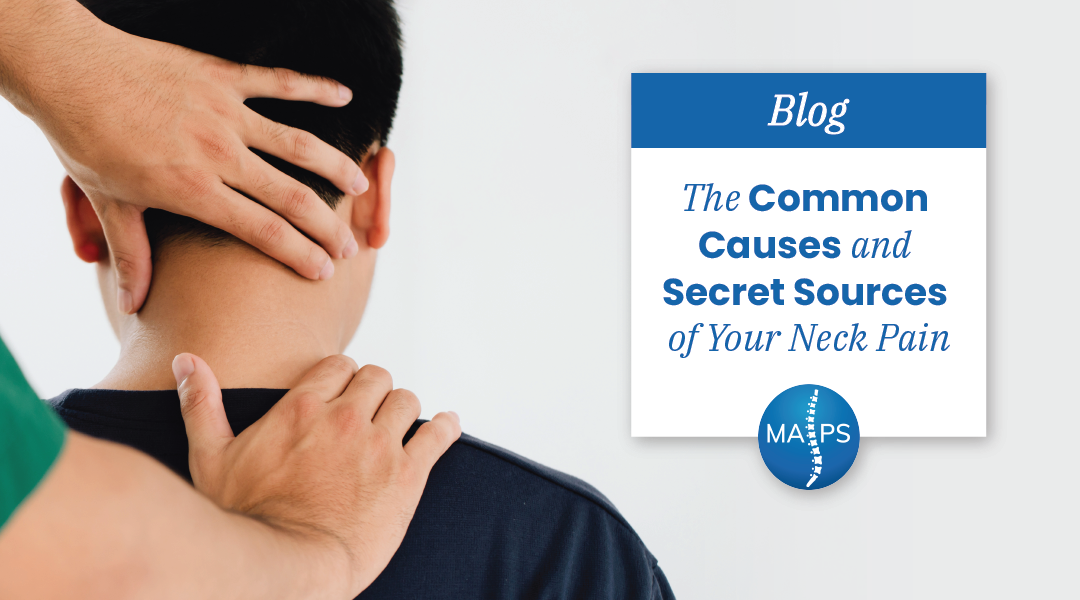The Common Causes and Secret Sources of Your Neck Pain


Imagine carrying a 10-pound bowling ball for an entire day—how long do you think it would take until you experienced fatigue, discomfort, and strain? The human head weighs about that much, and most of that load is distributed through the spine and supported by a web of muscles, tendons, ligaments, and cushioning discs for pain-free positioning. Unfortunately, common and surprising habits can challenge this structural alignment, causing up to 50% of adults to experience chronic neck pain annually. What are some sources of this condition, and how can you count on the MAPS Center for Pain Control team to help you find neck pain relief?
Poor Posture Plays a Role
Since a key to a healthy, pain-free neck is the proper alignment of the head over the spine, it makes sense that poor posture is a prime factor in many neck pain conditions:
- Slouching when standing or seated projects the head forward of the spine, which increases pressure on the spinal junction between the neck and upper back and strains the muscles and tissues that support the head.
- “Tech Neck” is another version of forward projection and is increasingly common due to the increased use of mobile devices like phones, tablets, and laptops.
- Sleeping with too full or flat pillows can move the neck out of alignment while you rest, contributing to pain.
- Poor ergonomics at your workstation can also lead to neck pain. For example, monitors, desk surfaces or keyboards, and armrests that are too high or low can cause you to hold your body in an unnatural position that fatigues muscles and irritates nerves.
Beyond a compromised posture, many daily habits can also be the source of your neck pain, including:
- Shoulder Pain – In many cases, what we experience as “neck pain” is tension in the muscles and tissues supporting the shoulders and arms. This muscle tissue passes through the space at the back of the neck, upper back, and between the neck and shoulders and can lead to pain in unexpected ways. Working with a physical therapist can ensure you’re strengthening the muscles around these mobile joints and moving soundly.
- Smoking – While many studies have proven the detrimental consequences of smoking, one of the lesser-known impacts is on the spine. Smoking dehydrates the neck and back discs, decreasing their ability to cushion and disperse the head’s weight. Smoking can also harden vessels that carry oxygen to the area, making it harder for these tissues to be nourished by the body. Quitting smoking as early as possible can help to prevent worsening neck pain.
- Your Daily Drive – With expanding cityscapes and an abundance of cars on the road, some commute between home and work near the 60-90 minute mark. Sitting still for that length of time can be straining enough, but it adds poorly positioned elements to the vehicle, and the tension can compound any physical stress from the work day. To alleviate the impact of your commute, ensure your seat back supports an upright position for spinal alignment, your steering wheel and hand positions are adjusted to relieve shoulder tension, and mirrors are aligned with your gaze to avoid straining.
How Can MAPS Help?
At MAPS Centers for Pain Control, our double board-certified physicians are dedicated to providing a multi-modal approach for your neck pain treatment. So no matter the source of your discomfort, you’ll receive the most comprehensive and cutting-edge treatments available in non-surgical and regenerative medicine today.
Injection-based therapies offer rapid, non-surgical neck pain relief and can include trigger point injections to soothe muscle pain and tension, facet joint injections using a local anesthetic and precision imaging for pain-relief medications, and cervical epidurals for lasting relief from inflammation, pain, tingling, or numbness.
Minimally invasive and medically advanced options like radiofrequency ablation, kyphoplasty, vertebroplasty, spinal cord stimulator implantation and spinal decompression provide long-term relief for complex chronic pain conditions.
Comprehensive neck pain treatment involves stabilizing and strengthening, which may include bracing when necessary and the rehabilitative support of physical therapy.
We recognize that chronic pain impacts every aspect of your life, so we use every tool available to alleviate your pain as quickly and effectively as possible. No condition is too complex—contact us today for your individualized care plan and leave neck pain behind!

